Since the 1950s Mercedes-Benz has been popular with Australian truck operators. The introduction of the new-generation in 2016 has seen that popularity skyrocket
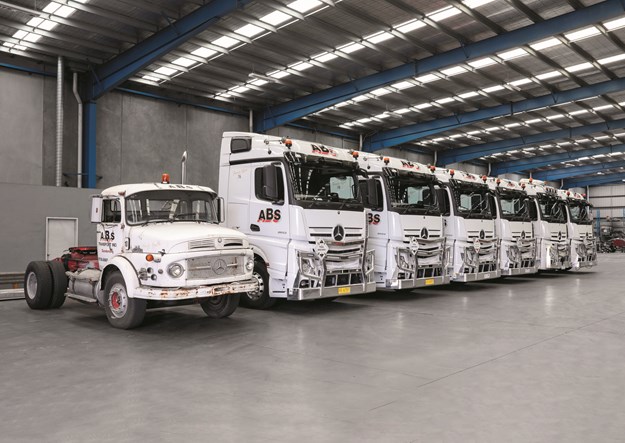 |
|
Melbourne-based operator ABS Transport is a long-time Benz fan, with its fleet including everything from an old 1418 through to the new-generation of trucks launched locally in 2016
|
Heavy-duty trucks wearing the three-pointed star are once again a common sight on Australian roads.
The latest generation of big Mercedes-Benz trucks has been a sales hit since they arrived in late 2016, reminding many of just how popular the brand has been.
FIRST SIGHTINGS
Australians have had a long relationship with Mercedes-Benz trucks dating back to the early 1950s when trucks were assembled in Melbourne from CKD kits sent from Germany.
Local assembly of Mercedes-Benz trucks was carried out in four different locations over the years, including a line on the grounds of the current Daimler Truck and Bus Australia Pacific head office in Mulgrave, Victoria.
The truck that would really put Mercedes-Benz on the map in Australia was the 1418 (see separate story on page x) that was introduced in 1965. There are several prominent Australian transport operators who built their businesses with the help of the tough and efficient LS 1418.
Even though production ceased in 1978, you can still find 1418s working hard to this day at some operations, often as a yard tug.
Mercedes-Benz moved to the ‘forward-control’ LPS 1418 in 1968. This is the first of the cab-over models that would come to dominate European roads and become the go-to truck for many operators in Australia. A newspaper ad from the time boasted of 205hp (153kW) from the OM346 direct-injection diesel and had a price of just $13,608 including tax. Sounds like a good deal!
Cab-over NG models would follow from 1975, joining the rugged bonneted 911; while the SK was introduced in 1989.
The SK became the first truck sold in Australia fitted with anti-skid brakes as standard. You can still see many of the NG and SK Mercedes-Benz trucks working away today.
Indeed, veteran truck driver Howard Dicker still gets behind the wheel of his 2233 SK Mercedes-Benz to haul material for his family’s company in Kingston, South Australia. It has done some 3.5 million km and Howard reckons its sits on the road beautifully.
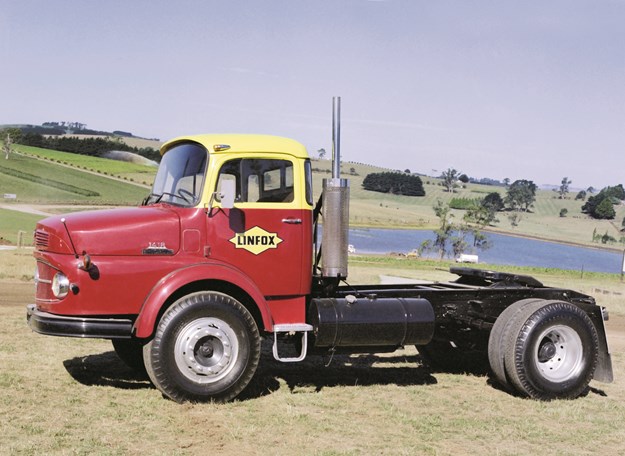 |
|
There are several prominent Australian transport operators who built their businesses with the help of the tough and efficient LS 1418
|
NEW STARS RISING
The new Actros was introduced in Europe in 1995 and arrived in Australia in 1998. It was an advanced truck with a range of clever innovations, including a lightweight frame, electronic brakes as standard, ventilated discs all round, a CAN bus electrical system and an aerodynamically designed cab. There was also a Telligent three-pedal transmission that pre-selected the synchromesh.
Mercedes-Benz also introduced an all-new family of V6 and V8 engines that delivered impressive fuel economy and performance. Unfortunately, the engineers pushed the engines too hard and there were some frustrating engine failures initially.
Mercedes-Benz had not been able to undertake local testing of the truck, so it had not been aware of potential issues. The company worked hard to keep customers moving and its engineers vowed to never introduce a new model without a significant local testing program.
A raft of changes was made and the greatly improved and vastly more durable second-generation Actros arrived in Australia in 2007. This model did much to win back customers for the brand with an offering of both Euro 4 and Euro 5 engines that arrived well before that emission standard was mandated by the federal government.
The new model was also made available with the revolutionary active brake assist (ABA), which used radar to detect a moving object in front of the truck and automatically hit the brakes.
It also introduced the Powershift 1 automated manual transmission with constant mesh, which was a two-pedal system.
In 2009, the first SLT heavy hauler arrived in Australia with a 250-tonne plus weight rating and three of them were used a mega construction job in the mining industry.
 |
|
The SK became the first truck sold in Australia fitted with anti-skid brakes as standard
|
NEW GENERATION
The following year saw the introduction of the third-generation Actros, which introduced the Euro 5 EEV (enhanced environmental vehicle) emission rating (even cleaner than Euro 5).
Mercedes-Benz continued with its safety push with electronic stability control introduced as standard on all 6×4 prime movers; while the latest generation of ABA was also offered.
Another ABA upgrade followed in 2012 and there were some minor changes, such as hypoid axle options on particular models, which delivered excellent fuel economy.
A heavy-haul SLT version was also offered, now with a smart turbo clutch, and several were dispatched to construction sites and mining sites in remote parts of Australia.
By now, the Actros was seen as a solid bet. The niggles had been ironed out long ago and the truck was well suited but there were holes in the line-up that would not be filled until the new truck arrived here.
Over in Europe, Mercedes-Benz was already selling the all-new Actros. Introduced there in mid-2011, it represented a huge step forward over the existing truck. The V6 and V8 engines were gone, replaced by a whole new family of in-line six-cylinder engines, while improved AMT transmissions were introduced along with new interiors.
The truck sported a dramatic new design language, which was both aggressive and aerodynamic. It also rode so much better than the previous model, sitting solidly even over the bumpiest roads.
The new model represented a big jump over the existing product, much like the new Actros had when it first arrived here.
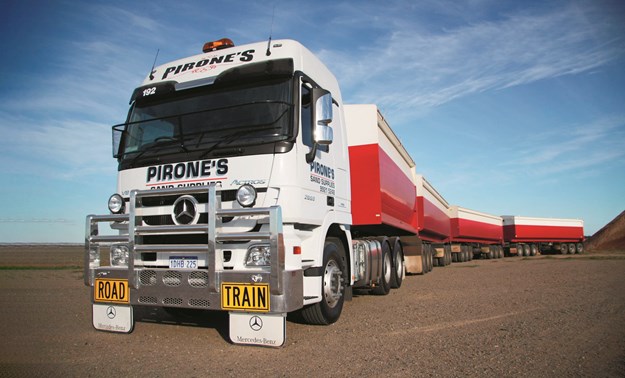 |
|
A raft of changes was made and the greatly improved and vastly more durable second-generation Actros arrived in Australia in 2007
|
Mercedes-Benz Australia resisted the urge to bring the truck to Australia straight away and decided to instead wait until it could be sure that it could get the right specification truck for Australia. Then it invested in an 18-month local evaluation program involving 35 customers, 20 trucks and well over one million km travelled in trucks wearing a matt-black wrap.
This would enable the Mercedes-Benz team to make sure the technology was up to the job and also make sure the specification selected was exactly what Australian customers wanted.
The Australian team worked on locally-developed long-range fuel tanks that would suit the truck but also deliver adequate range required by local operators.
An Australian inner-sprung mattress was selected, a local-developed information/entertainment system was tested and bull bars were evaluated to make sure they worked with the new integrated safety systems.
In October 2016, Mercedes-Benz was finally ready to launch the new Mercedes-Benz truck range. The Actros name was not used locally, with the team focusing instead on the numbers that had long been a part of the naming pattern. That means, for example, that the 2663 is a 26-tonne rated truck, with 63 indicating it generates 630hp (470kW).
It was an immediate success and Mercedes-Benz had delivered the right truck at the right time with the power, efficiency and safety that its customers had been waiting for.
The high-performance 13-litre 530hp (395kW) 2653 was one of the most popular models early on thanks to its remarkable fuel economy; while the 16-litre engine, which cranked out up to 630hp, was also winning a lot of friends.
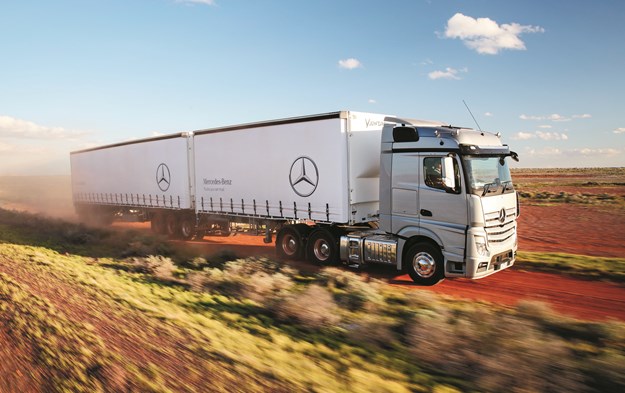 |
|
The new Actros certainly looks the goods!
|
Mercedes-Benz introduced the new truck with Euro 6 across the entire range, not just specific models, and operators found the new truck not only delivered fuel economy savings over the previous model, but also used less AdBlue.
Word soon spread about the fuel efficiency of the new Mercedes-Benz truck and it started attracting customers from other European manufacturers as well as operators who had always purchased traditional bonneted trucks but were willing to give the Mercedes-Benz a go because it was so economical.
The new truck soon broke sales records to become the most popular Mercedes-Benz truck in Australia ever, which is quite something given the success of the mighty 1418.
Mercedes-Benz offered a free scheduled servicing offer on most new-generation trucks, which could well still be active on many of the used trucks currently available. The ‘Best Basic’ coverage is tied to the truck, not the customer, and covered the trucks for 500,000km or five years (whichever came first).
Mercedes-Benz is now looking to introduce further improvements to keep its truck out the front of the pack including cameras to replace traditional mirrors to increase visibility and cut
Heavy-duty trucks wearing the three-pointed star are once again a common sight on Australian roads.
The latest generation of big Mercedes-Benz trucks has been a sales hit since they arrived in late 2016, reminding many of just how popular the brand has been.
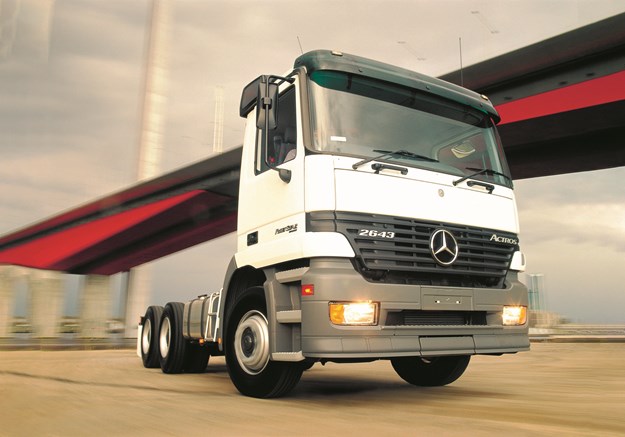 |
|
The new Actros was introduced in Europe in 1995 and arrived in Australia in 1998
|
